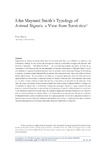Mostrar o rexistro simple do ítem
John Maynard Smith's Typology of animal signals: a view from Semiotics
| dc.contributor.author | Maran, Timo | es_ES |
| dc.date.accessioned | 2014-10-02T12:31:39Z | |
| dc.date.available | 2014-10-02T12:31:39Z | |
| dc.date.issued | 2012 | es_ES |
| dc.identifier.citation | Culture of communication / Communication of culture, 2012: 751-760. ISBN: 978-84-9749-522-6 | es_ES |
| dc.identifier.isbn | 978-84-9749-522-6 | es_ES |
| dc.identifier.uri | http://hdl.handle.net/2183/13376 | |
| dc.description.abstract | [Abstract] Approaches to animal communication have for the most part been quite different in semiotics and evolutionary biology. In this context the writings of a leading evolutionary biologist who has been also attracted to semiotics — John Maynard Smith — are an interesting exception and object of study. In my presentation I will focus on the use and adaptation of semiotic terminology in Maynard Smith’s works with reference to general theoretical premises both in semiotics and evolutionary biology. In developing a typology of animal signals, Maynard Smith employs the concepts of icon, index and symbol to denote distinct signal classes. He uses «indices» or «indexes» to express a signal type where the relation between signal properties and meaning is restricted because of physical characteristics. Such approach also points out the issue of motivatedness of signs that has had a long history in semiotics. In the final part of the paper the usage and content of the concepts of signal form and meaning in Maynard Smith’s writings will be analysed. It appears that in evolutionary biology the meaning of signal is a vague concept that may denote a variety of things from an animal’s specific physiological status to artificial theoretical constructs. It also becomes evident that in actual usage the concept of signal often includes references to the receiver’s activity and interpretation that belong rather to the characteristics of sign process. The positive influence of Maynard Smith’s works on semiotics could lie in paying attention to the role of physical necessities in animal communication. Physical constraints and relations seem to have a significant role also in semiotic processes although this is not always sufficiently studied or understood in semiotics. | es_ES |
| dc.language.iso | eng | es_ES |
| dc.publisher | Universidade da Coruña | es_ES |
| dc.title | John Maynard Smith's Typology of animal signals: a view from Semiotics | es_ES |
| dc.type | info:eu-repo/semantics/conferenceObject | es_ES |
| dc.rights.access | info:eu-repo/semantics/openAccess | es_ES |






